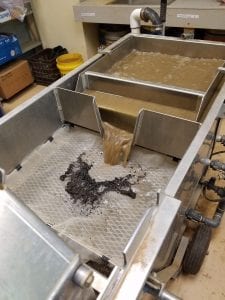Something I’ve found myself thinking more and more often is that working in the wet lab, processing flotation samples, is relaxing. Now, this could just be the tired mind of a grad student enjoying a few moments of peace and there’s some truth to that. However, there’s more to it. It’s been feeling like a productive therapy session. There’s something fulfilling about taking liters worth of samples and revealing what the soil has hidden, particularly of the legacy collections that have been keeping their secrets for thirty or forty years. Although, I don’t know what will happen with the materials retrieved once they have been bagged and labeled. Sure, some materials will be examined sooner or later for research questions that might not have been asked yet. However, I have a suspicion that those of the legacy collections, which sometimes are more plastic (from the degrading trash and/or sandwich bags originally used to store them) than anything else, may just be stored away indefinitely. It seems like a shame, but I hope this material will be examined at some point. It may seem sad, but it’s fun to wonder what this material could contribute to archaeology. Perhaps this will inspire me to pursue researching micro-artifacts, including those of these abandoned collections That’s enough of my rambling for now.
For anyone unfamiliar with flotation or what exactly I’m talking about, keep reading and I’ll try to make it short. If I didn’t make this clear earlier, flotation is a process that separates tiny artifacts, plant materials, and the like from soil through water. These artifacts separate into two groups called the light and heavy fractions. Perhaps unsurprisingly, the light fraction floats in the water while the heavy does not. We at IUP are fortunate enough to have a flotation machine which cuts the amount of time and effort put into collecting these microartifacts. You do not need a flotation machine to do flotation, a bucket of water and a sieve will suffice, but it makes the process far easier. In the case of a flotation machine, you have a pump that keeps the water flowing and helps to agitate the sample and separate the soil and microartifacts. You pour a sample into the main compartment, gently. The water flows through an opening, carrying the light fraction, and then through a screen that collects the light fraction. The heavy fraction remains in a removable screen in the main compartment and gets collected once the light fraction has finished collecting. The machine gets cleaned out when changing sites, and just every so often, to avoid accidental contamination and to keep the machine functioning properly. If I left you with more questions than answers, leave a comment and I’ll try to answer you ASAP.
